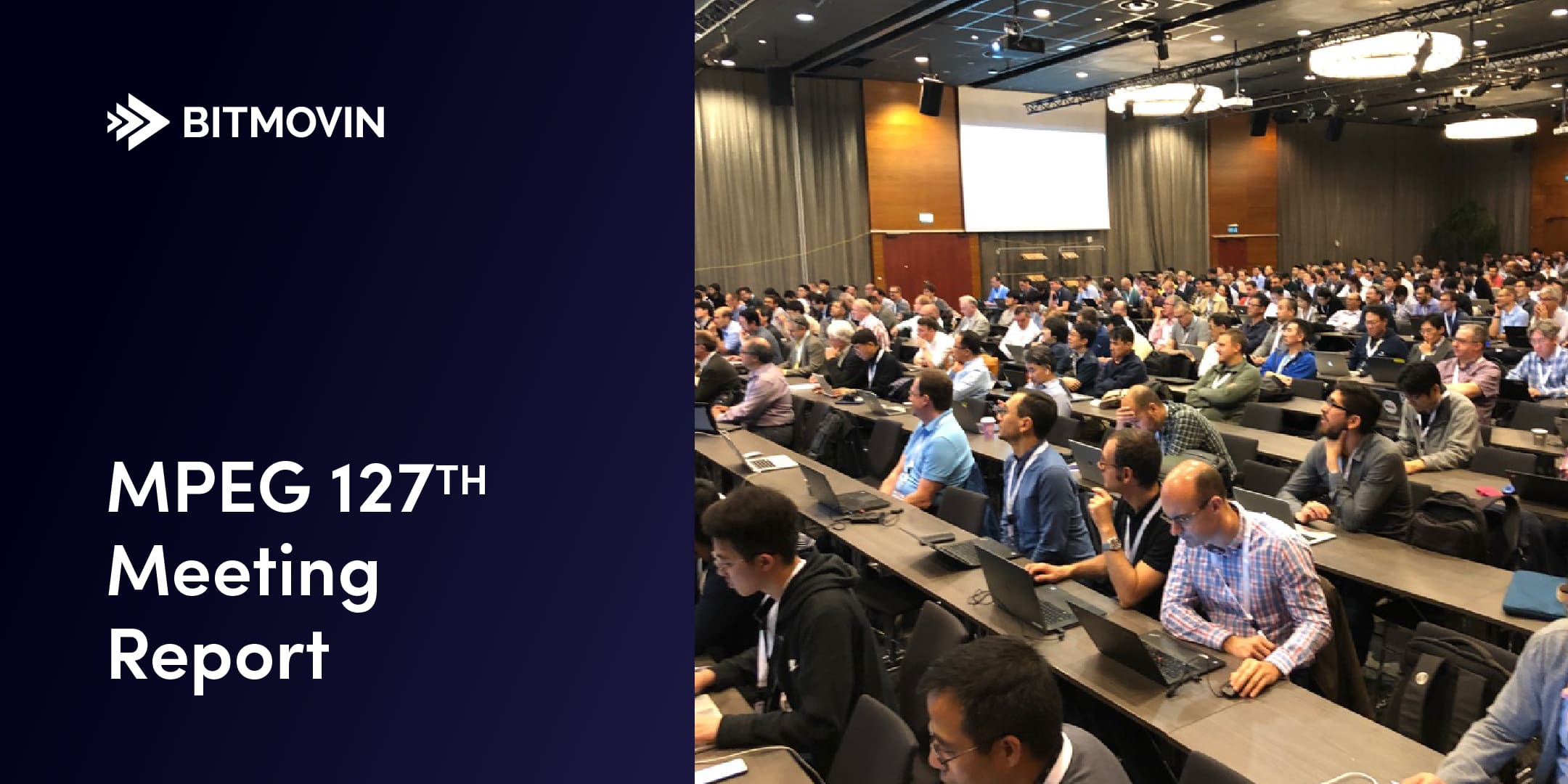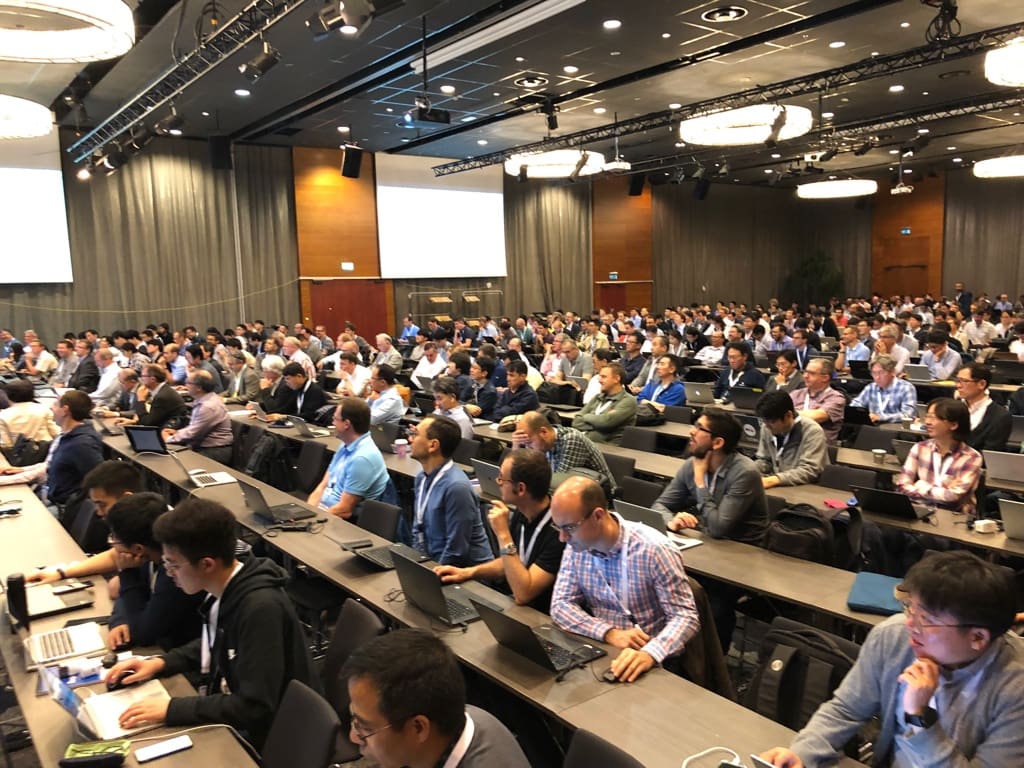
The 127th MPEG meeting concluded on July 12, 2019 in Gothenburg, Sweden with the following topics:
- Versatile Video Coding (VVC) enters formal approval stage, experts predict 35-60% improvement over HEVC
- Essential Video Coding (EVC) promoted to Committee Draft
- Common Media Application Format (CMAF) 2nd edition promoted to Final Draft International Standard
- Dynamic Adaptive Streaming over HTTP (DASH) 4th edition promoted to Final Draft International Standard
- Carriage of Point Cloud Data Progresses to Committee Draft
- JPEG XS carriage in MPEG-2 TS promoted to Final Draft Amendment of ISO/IEC 13818-1 7th edition
- Genomic information representation – WG11 issues a joint call for proposals on genomic annotations in conjunction with ISO TC 276/WG 5
- ISO/IEC 23005 (MPEG-V) 4th Edition – WG11 promotes the Fourth edition of two parts of “Media Context and Control” to the Final Draft International Standard (FDIS) stage
The corresponding press release of the 127th MPEG meeting can be found here: https://mpeg.chiariglione.org/meetings/127. In this report we will focus on video coding aspects (VVC and EVC), adaptive streaming stuff (CMAF and DASH), and immersive media applications (PCC).

Versatile Video Coding (VVC)
The Moving Picture Experts Group (MPEG) is pleased to announce that Versatile Video Coding (VVC) progresses to Committee Draft, experts predict 35-60% improvement over HEVC
The development of the next major generation of video coding standard has achieved excellent progress, such that MPEG has approved the Committee Draft (CD, i.e., the text for formal balloting in the ISO/IEC approval process).
The new VVC standard will be applicable to a very broad range of applications and it will also provide additional functionalities. VVC will provide a substantial improvement in coding efficiency relative to existing standards. The improvement in coding efficiency is expected to be quite substantial – e.g., in the range of 35–60% bit rate reduction relative to HEVC although it has not yet been formally measured. Relative to HEVC means for equivalent subjective video quality at picture resolutions such as 1080p HD or 4K or 8K UHD, either for standard dynamic range video or high dynamic range and wide color gamut content for levels of quality appropriate for use in consumer distribution services. The focus during the development of the standard has primarily been on 10-bit 4:2:0 content, and 4:4:4 chroma format will also be supported.
The VVC standard is being developed in the Joint Video Experts Team (JVET), a group established jointly by MPEG and the Video Coding Experts Group (VCEG) of ITU-T Study Group 16. In addition to a text specification, the project also includes the development of reference software, a conformance testing suite, and a new standard ISO/IEC 23002-7 specifying supplemental enhancement information messages for coded video bitstreams. The approval process for ISO/IEC 23002-7 has also begun, with the issuance of a CD consideration ballot.
Bitmovin welcomes these efforts and is working on effective integration of new codec including but not limited to VVC into its product portfolio and also appreciates efforts by the Media Coding Industry Forum (MC-IF) for working on appropriate licencing terms.
Essential Video Coding (EVC)
MPEG-5 Essential Video Coding (EVC) promoted to Committee Draft
Interestingly, at the same meeting as VVC, MPEG promoted MPEG-5 Essential Video Coding (EVC) to Committee Draft (CD). The goal of MPEG-5 EVC is to provide a standardized video coding solution to address business needs in some use cases, such as video streaming, where existing ISO video coding standards have not been as widely adopted as might be expected from their purely technical characteristics.
The MPEG-5 EVC standards includes a baseline profile that contains only technologies that are over 20 years old or are otherwise expected to be royalty-free. Additionally, a main profile adds a small number of additional tools, each providing significant performance gain. All main profile tools are capable of being individually switched off or individually switched over to a corresponding baseline tool. Organizations making proposals for the main profile have agreed to publish applicable licensing terms within two years of FDIS stage, either individually or as part of a patent pool.
Bitmovin acknowledges all efforts enabling efficient adoption of video codecs for streaming applications and services. One open issue is whether the parallel development of both VVC and EVC will have any side effects on these standards or existing standards, specifically those having “not been as widely adopted as might be expected from their purely technical characteristics”.
Common Media Application Format (CMAF)
MPEG ratified the 2nd edition of the Common Media Application Format (CMAF)
The Common Media Application Format (CMAF) enables efficient encoding, storage, and delivery of digital media content (incl. audio, video, subtitles among others), which is key to scaling operations to support the rapid growth of video streaming over the internet. The CMAF standard is the result of widespread industry adoption of an application of MPEG technologies for adaptive video streaming over the Internet, and widespread industry participation in the MPEG process to standardize best practices within CMAF.
The 2nd edition of CMAF adds support for a number of specifications that were a result of significant industry interest. Those include
- Advanced Audio Coding (AAC) multi-channel;
- MPEG-H 3D Audio;
- MPEG-D Unified Speech and Audio Coding (USAC);
- Scalable High Efficiency Video Coding (SHVC);
- IMSC 1.1 (Timed Text Markup Language Profiles for Internet Media Subtitles and Captions); and
- additional HEVC video CMAF profiles and brands.
This edition also introduces CMAF supplemental data handling as well as new structural brands for CMAF that reflects the common practice of the significant deployment of CMAF in industry. Companies adopting CMAF technology will find the specifications introduced in the 2nd Edition particularly useful for further adoption and proliferation of CMAF in the market.
Bitmovin supports CMAF since the beginning and recently worked on low-latency for CMAF resulting in winning the DASH-IF Excellence in DASH award for bandwidth prediction in low-latency chunked streaming, in collaboration with Alpen-Adria-Universität Klagenfurt, National University of Singapore, and Ozyegin University & Networked Media [link]. Thus, Bitmovin is committed working towards integration of recent advances of the CMAF specification in order to address raising business needs of its customers.
Dynamic Adaptive Streaming over HTTP (DASH)
MPEG approves the 4th edition of Dynamic Adaptive Streaming over HTTP (DASH)
The 4th edition of MPEG-DASH comprises the following features:
- service description that is intended by the service provider on how the service is expected to be consumed;
- a method to indicate the times corresponding to the production of associated media;
- a mechanism to signal DASH profiles and features, employed codec and format profiles; and
- supported protection schemes present in the Media Presentation Description (MPD).
It is expected that this edition will be published later this year.
Bitmovin’s contribution to MPEG-DASH is indisputable and can be found in the traces of its history resulting in the research and development of the current products encoding, player, and analytics. The reason why the 4th edition has been produced relatively quick after finalizing the 3rd edition is due to the ISO approval/publication process and for details you have to invite me for a drink ;).
Carriage of Point Cloud Data
MPEG progresses the Carriage of Point Cloud Data to Committee Draft
At its 127th meeting, MPEG has promoted the carriage of point cloud data to the Committee Draft stage, the first milestone of ISO standard development process. This standard is the first one introducing the support of volumetric media in the industry-famous ISO base media file format family of standards.
This standard supports the carriage of point cloud data comprising individually encoded video bitstreams within multiple file format tracks in order to support the intrinsic nature of the video-based point cloud compression (V-PCC). Additionally, it also allows the carriage of point cloud data in one file format track for applications requiring multiplexed content (i.e., the video bitstream of multiple components is interleaved into one bitstream).
This standard is expected to support efficient access and delivery of some portions of a point cloud object considering that in many cases that entire point cloud object may not be visible by the user depending on the viewing direction or location of the point cloud object relative to other objects. It is currently expected that the standard will reach its final milestone by the end of 2020.
Bitmovin is actively researching novel means enabling immersive media access — in collaboration with Alpen-Adria-Universität Klagenfurt — resulting in first publications in renowned conferences such as “Dynamic Adaptive Point Cloud Streaming” (in ACM Packet Video 2018) and “Towards 6DoF HTTP Adaptive Streaming Through Point Cloud Compression” (accepted for publication in ACM Multimedia 2019).
Finally, the unofficial highlight of the 127th MPEG meeting we certainly found while scanning the scene in Gothenburg on Tuesday night…





